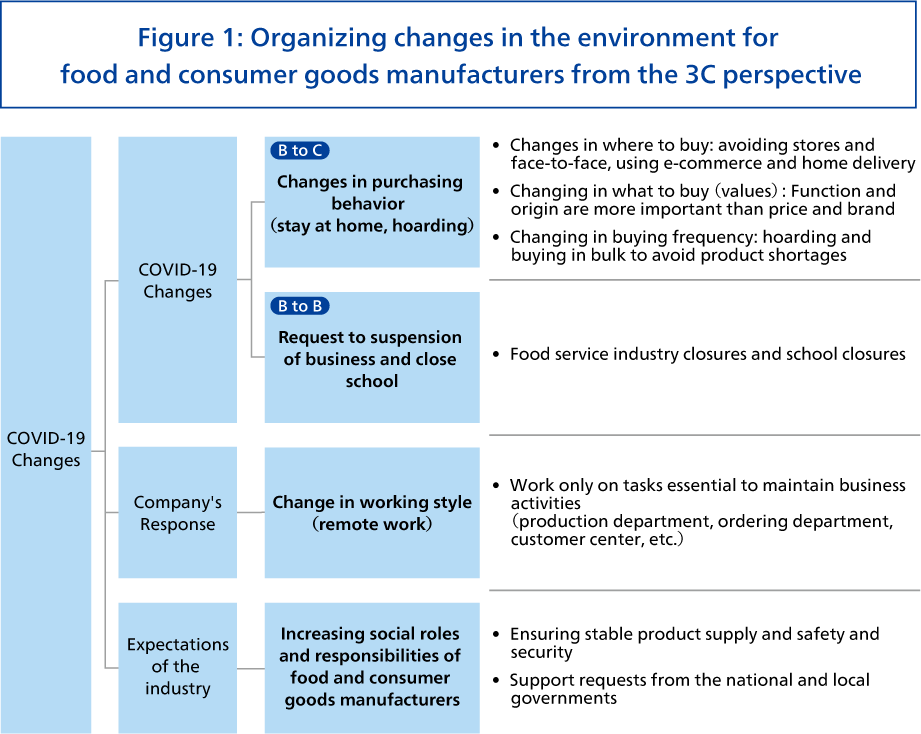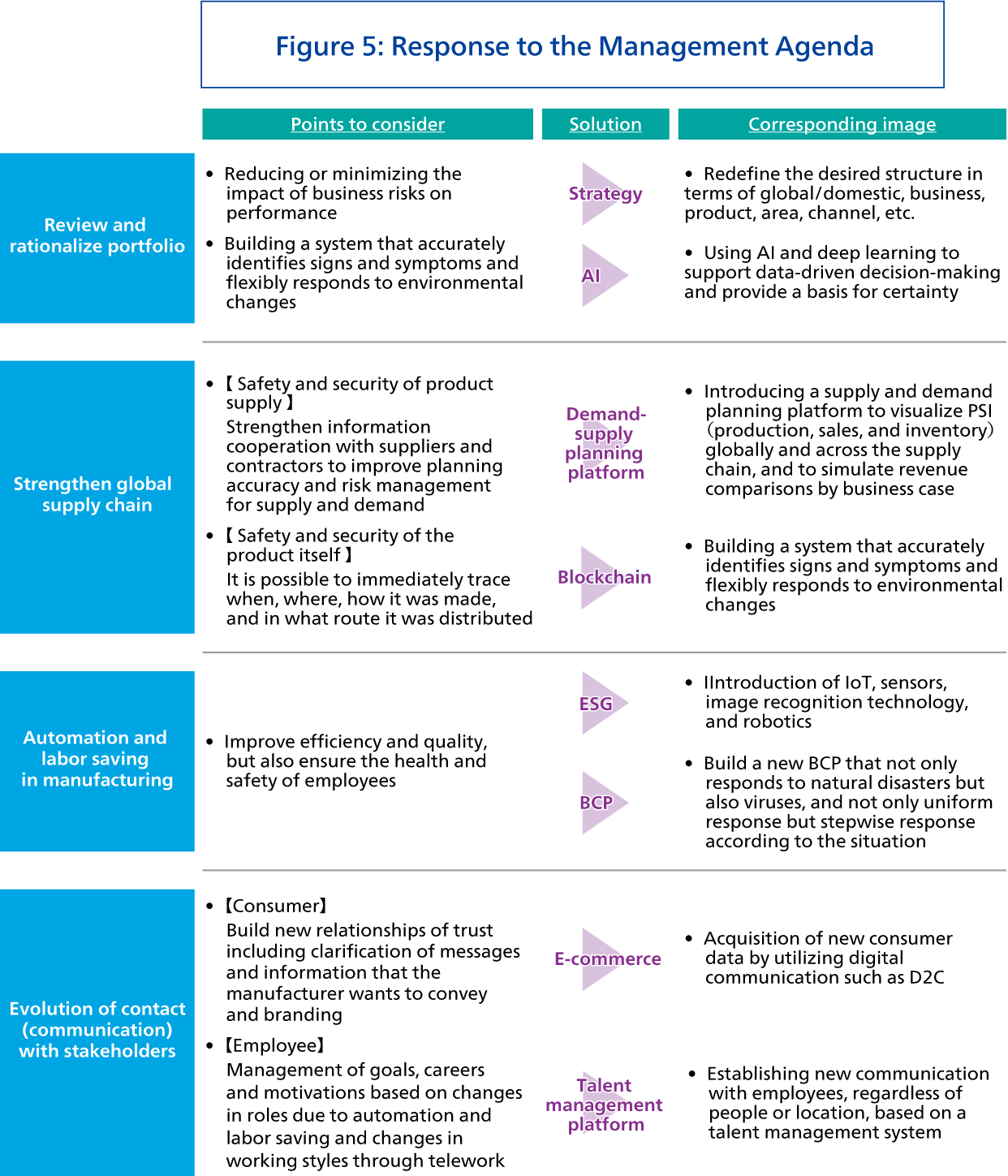COVID-19 has brought about various changes in people's lives. In this paper, we systematically summarize the impact on environmental changes and corporate activities from the perspective of food and consumer goods manufacturers, who are closely involved in our lives. We also discuss how food and consumer goods manufacturers should respond in the future, given these changes.
Impact of COVID-19 on Food and Consumer Goods Manufacturers and Future Responses
- Food
- Consumer Goods
- Management Strategy/Reformation

Contents
Environmental changes due to COVID-19
First, we summarize how COVID-19 changed the environment for food and consumer goods manufacturers from the perspective of the "3Cs" of customer, company and competitor(Figure 1).
Due to changes in purchasing behavior and requests for suspension of business and school closures, the previous balance between supply and demand was greatly disrupted. This was compounded by the downsizing of the field system due to remote work and the responsibilities of manufacturers as suppliers. We discuss in detail how these changes in the environment affected corporate activities from the perspective of management resources(money, product, employees, and information).

Demand trends due to environmental changes
Next, we summarize which food and consumer goods have continued to sell and which have stopped selling due to these environmental changes(Figure 2). Not only did demand for professional products shrink due to school closures, suspension of work and remote work, but demand for cosmetics and other luxury products also shrank as opportunities to get out of the house dropped dramatically. On the other hand, increasing awareness of stay-at-home and COVID-19 infection prevention has increased the demand for hygiene products such as instant foods and other stored foods and masks to the extent that inventories are tight. In response to these demand trends, food and consumer goods manufacturers produced various financial statements showing that some companies that were able to cover the decline in cosmetics sales with hygiene products, while other companies that had high ratios of professional products suffered a negative impact on business performance. From the perspective of monetization of management resources, there is no doubt that there have been differences in the business and product mixes, and that portfolio composition has been shown to impact business performance.

Impact on the value chain due to environmental changes and responses
Next, we summarize the impacts and responses on the value chain(Figure. 3). Although the impacts are wide-ranging, the following are summarized from the perspective of management resources other than those directly associated with monetization as mentioned above.
-
Product perspective Confusion occurred in the supply chain due to the suspension of procurement functions at overseas group companies, cooperating factories, and manufacturing contractors.
-
Employee perspective The risk of COVID-19 infection has given rise to circumstances under which manpower is required to increase production.
-
Information perspective In addition to a flood of inquiries seeking information on inventory, product functions, and safety, the spread of erroneous information has also been seen on SNS.

Future management agenda as reflected by COVID-19
The status of COVID-19 infections continues to be unreadable. It is certain, however, that there will be no complete return to the pre-COVID-19 state of affairs, and companies and consumers will move stepwise toward the new normal(a new set of commonsense assumptions for the new circumstances). Furthermore, there is a possibility that a new emergency will occur in the future. Based on these lessons, we would like you to face the future as a management agenda regarding preparations for the future. It seems to us that areas that food and consumer goods manufacturers had been aware of but had not been able to tackle in the past have become clearer as management agenda components due to COVID-19. Future impacts are organized from the perspective of management resources, and the responses to the respective management agenda items are shown in the next section(Figure 4).

How to respond to the respective management agendas of money, product, employees and information
-
Money:
There are various perspectives for reviewing and optimizing a portfolio, including global and domestic, business, product, area, and channel. First of all, manufacturers should review the risks involved in its future corporate activities and consider the portfolio it should aim for from each perspective. At the same time, manufacturers should also consider building a system that enables it to detect signals and signs of environmental changes in advance.
-
Product:
In order to strengthen the global supply chain, it is important to establish a system that links suppliers, contractors, and the value chain within the company to provide real-time visibility of product supply and demand and the product supply process.
-
Employees:
Manufacturers should be aware of ESG and BCP in addition to conventional efficiency and quality improvements, since manufacturing automation and manpower conservation will need to be addressed from the perspective of ensuring the safety and health of employees.
-
Information:
In response to COVID-19, it is necessary to reconsider the need for communication with stakeholders concerning the company with respect to consumers and employees. In an increasingly uncertain business environment, no static responses will remain safe indefinitely. In the future, the ability to detect alerts in advance and take preventive measures, as well as the speed and flexibility to do so, will be the very essence of global competitiveness. Moreover, digitalization(digital transformation)will also be an unavoidable requirement in realizing these goals. Figure 5 summarizes the concept of each management agenda.

Finally, the fight against COVID-19 is not yet over. On the other hand, some food and consumer goods manufacturers have already started to re-plan their business strategies and investments with an eye to the future. We hope that this article will serve as a catalyst for the next actions by which to address the social roles and responsibilities of food and consumer goods manufacturers, which are expected to be renewed through COVID-19.
Click here for inquiries and consultations
